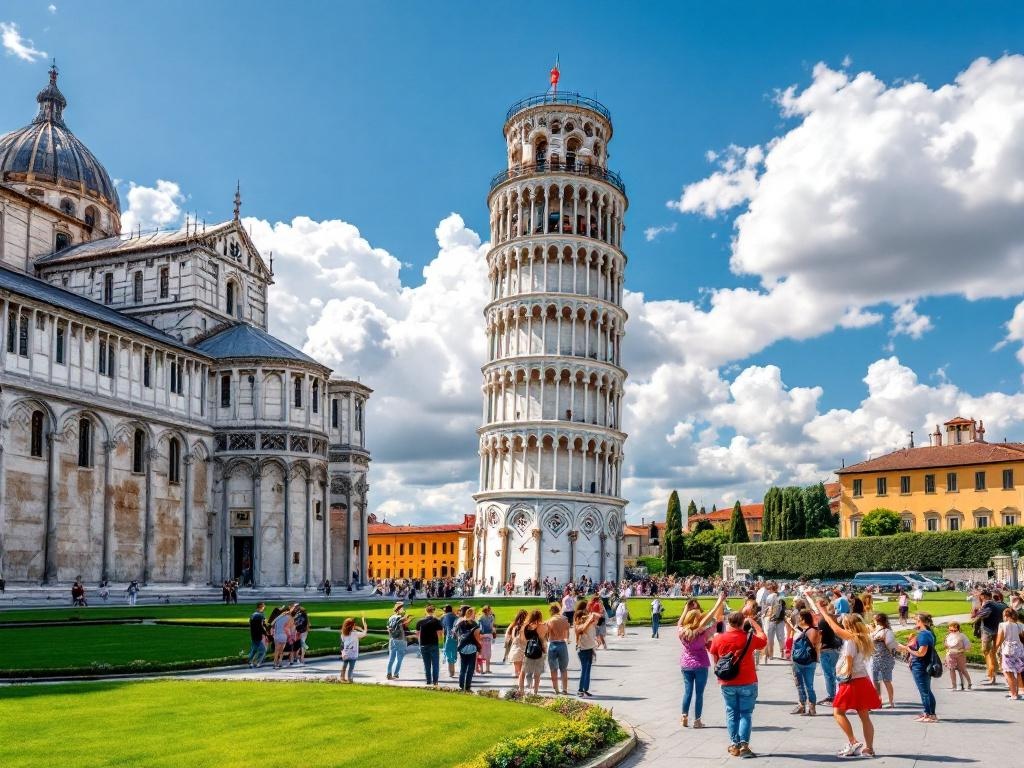Visiting the Leaning Tower of Pisa
Journey to Italy and witness the world-famous Leaning Tower of Pisa! This architectural marvel, known for its distinctive tilt, offers a unique experience. Discover the history of its unintentional lean, caused by soft ground and a shallow foundation. Explore the stunning Romanesque design and climb the 294 steps for breathtaking views of Pisa. Book your tickets online now to skip the lines and secure your spot at this iconic landmark in Piazza dei Miracoli. Don’t miss the chance to capture the perfect leaning pose selfie!
Important information

- The Leaning Tower of Pisa, built in 1173, leans due to soft ground and a shallow foundation. Modern engineering has stabilized it.
- The tower is located in Piazza dei Miracoli, a UNESCO World Heritage site, also home to the Cathedral, Baptistery, and Camposanto Monumentale.
- Book tickets online in advance, especially during peak season, to climb the tower and skip the lines. Climbing provides panoramic city views.
- Consider a guided tour for historical context or explore independently. Comfortable shoes are recommended for the 294-step climb.
- Pisa Centrale station offers train access, and parking is available near the Piazza. Pisa International Airport (PSA) is also an option.
Introduction to Visiting the Leaning Tower of Pisa
The Leaning Tower of Pisa, one of the Seven Wonders of the World, is instantly recognizable for its iconic tilt. Ascending to its summit offers an unforgettable experience.
History and Architecture of the Leaning Tower of Pisa
The construction of Pisa’s iconic Leaning Tower commenced in 1173. Almost immediately, the tower began its renowned tilt due to the soft, unstable ground beneath it, composed of clay, sand, and shells. Despite this instability, construction continued intermittently, finally concluding in the 14th century. This freestanding bell tower, an integral part of the Pisa Cathedral complex, showcases a Romanesque design attributed to Bonanno Pisano, evident in its marble arches and cylindrical structure.
The Lean
The lean is a direct consequence of the combined effect of the soft ground and the shallow, 3-meter foundation laid in 1173. Just five years later, in 1178, the south side began sinking more than the north, initiating the tower’s now-famous tilt.
An Architectural Marvel
Despite its unintentional lean, the tower remains an architectural marvel, notable for its circular design and extensive use of marble. Although the tilt is a visible flaw, builders attempted to compensate by adding taller columns to one side. However, the fundamental issue—the inadequate foundation for the soft ground—persisted. Modern engineering interventions have since stabilized the tower, halting further leaning and even slightly reducing the existing tilt.
Why Does the Leaning Tower of Pisa Lean?
The Leaning Tower of Pisa’s famous tilt is due to the soft ground beneath it, a mix of clay, sand, and shells. This unstable foundation, coupled with its shallow depth, proved insufficient to support the tower’s weight, causing it to lean during its 12th-century construction. The tower’s lean has been stabilized through various interventions, including soil extraction and counterweights.
Architectural Achievements and Mistakes
The Leaning Tower of Pisa is renowned for its distinctive tilt, a consequence of a faulty foundation and soft ground. Construction began in 1173, and the lean became apparent as early as 1178 during the construction of the second floor. As more floors were added, engineers tried to correct the tilt, but the tower persisted in sinking. Despite its unstable base, the tower remains a stunning example of Romanesque architecture, featuring ornate marble arches and decorative columns. Ironically, the accidental lean has become its defining characteristic, transforming it into a popular tourist attraction.
Getting to Pisa and the Leaning Tower
Reaching Pisa’s iconic Leaning Tower is easy. You can fly into Pisa International Airport (PSA) and then take a taxi, shuttle, or public transportation. Another option is taking a train to Pisa Centrale station, which is a short walk from the tower. If you prefer driving, parking is available. Before you travel, make sure you have the necessary visa or permits. Check the latest entry requirements here: Verify travel entry requirements before you go
Transportation Options: Train and Parking
Pisa Centrale station offers direct connections to major Italian cities.
From the station, the Leaning Tower is a pleasant 20-minute stroll or a short bus trip.
Parking is available at Piazza dei Miracoli and Via Cammeo, but be sure to check for space and fees.
What to Know Before You Visit
Visit Italy’s Piazza dei Miracoli and its renowned Leaning Tower. The Piazza is always open, but the Tower’s hours change seasonally, so visit the official website for updates. Booking tickets online guarantees entry and lets you skip the lines, which is especially helpful during peak season. Ticket prices vary based on the experience; climbing the tower costs more than just visiting the grounds.
Location: Piazza dei Miracoli
The Leaning Tower of Pisa stands in Piazza dei Miracoli, a UNESCO World Heritage site. This famous piazza is also home to Pisa Cathedral, the Baptistery, and the Camposanto Monumentale.
Opening Times and Best Time to Visit
The Leaning Tower of Pisa is open to visitors from 9:00 AM to 10:00 PM. For a less crowded experience, arrive before 10:00 AM or between 4:00 PM and closing.
Ticket Prices and Reservations
Secure your climb up the Leaning Tower of Pisa with advance tickets. Due to limited availability, online booking is highly recommended. Reserve your tickets now!
Enhancing Your Visit
Enhance your visit to the Leaning Tower of Pisa with a guided tour for convenient access and valuable historical context, or explore independently at your own speed. Skip-the-line tickets offer valuable time savings, especially during peak season. Reserving tickets ahead of time is highly recommended. Ascend the tower for breathtaking views of Pisa and capture the iconic leaning pose with creative selfies. This is a memorable photo opportunity you won’t want to miss.
Guided Tours
Enhance your experience with a guided tour providing convenient access and historical context.
Independent Exploration
Explore at your own pace and discover the tower’s wonders independently.
Skip-the-Line Tickets
Save valuable time with skip-the-line tickets, especially beneficial during peak season.
Advance Reservations
Reserving tickets in advance is highly recommended to secure your spot.
Breathtaking Views
Ascend the tower for stunning panoramic views of Pisa.
Iconic Leaning Pose
Capture creative selfies with the iconic leaning tower.
Guided Tours and Self-Guided Options
Explore the tower’s history and architecture with a guided tour, often bypassing long queues. Alternatively, discover it independently at your own pace with a self-guided visit.
Skip-the-Line Tickets and Ticket Reservations
Skip the lines at the Leaning Tower of Pisa with skip-the-line tickets. Booking online guarantees your entry and saves you valuable time.
Climbing the Tower: A Unique Experience
Climbing the iconic Leaning Tower of Pisa is an unforgettable experience. The 294-step climb takes about 30 minutes and rewards you with breathtaking panoramic views of the city, including the Duomo and Baptistery. Comfortable shoes are recommended, and pre-booking tickets is strongly advised to avoid long queues.
Photo Opportunities and Best Angles for a Selfie
Capture stunning photos of the Leaning Tower of Pisa with these tips:
Strike the classic “holding it up” pose by crouching near the base for a fun, forced perspective effect.
Capture the tower’s full majesty from the Piazza dei Miracoli, positioning yourself in the foreground for a dramatic contrast in scale.
Consider the lighting. Sunrise, midday, and sunset each illuminate the tower differently, offering unique photo opportunities.
Exploring the Piazza dei Miracoli
Pisa’s Piazza dei Miracoli is not just home to the iconic Leaning Tower, but also showcases a trio of remarkable structures, each offering a unique cultural experience. The Pisa Cathedral, officially the Cathedral of Santa Maria Assunta, is a prime example of Romanesque architecture. The Baptistery, recognized as one of Italy’s largest, is famed for its exceptional acoustics. Finally, the Camposanto Monumentale offers a different perspective, serving as a historic cemetery adorned with intricate frescoes that are well worth exploring.
Other Attractions: Pisa Cathedral and Pisa Baptistery
Pisa’s Piazza dei Miracoli is renowned for its iconic Leaning Tower, but this famed square offers so much more. The nearby Cathedral and Baptistery boast breathtaking architecture, providing a glimpse into Italy’s rich history and culture. Visitors can explore the intricate details of the Cathedral and the equally impressive Baptistery. While the Leaning Tower is undoubtedly a must-see, the entire Piazza dei Miracoli delivers a truly captivating Italian experience.












